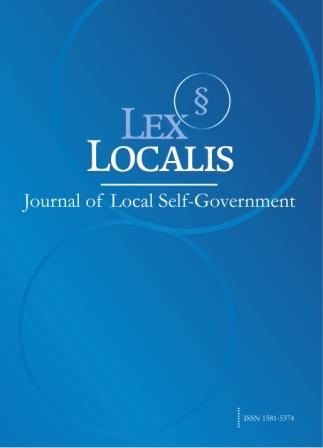Criteria for determining liability for medical negligence in the crime of medical malpractice and their development in legal practice
DOI:
https://doi.org/10.52152/3142Ključne besede:
structural equation modeling; path coefficient; direct utility; medical malpractice crimePovzetek
Based on the concepts and characteristics of medical malpractice crimes, this topic divides the criteria for determining medical negligence into subjective, objective, concrete, and abstract criteria, and finally completes the task of setting the criteria for determining the responsibility of medical negligence. In order to reduce the frequency of medical malpractice offenses, it advocates the addition of fines and qualification penalties to medical malpractice offenses, and supplements the understanding and determination standards of medical negligence. A sample of cases is identified and structural equation modeling is used to analyze in depth the mechanism of the medical negligence liability determination standard. Medical diagnosis result A7 has the strongest positive direct effect on the determination result, with a path coefficient of 0.401 (P < 0.001), and based on the total path effect value, medical diagnosis result A7 > medical notification obligation A6 > medical urgency A2 > medical reasonableness A1 > medical professionalism A5 > legal practice A8, suggesting that, in legal practice, medical diagnosis results largely determine whether or not to constitute the medical negligence for the crime of medical malpractice.
Literatura
Pillai, D. A. V. (2020). Determination of Damages in Medical Negligence Cases: An Overview. Available at SSRN 3579272.
Luther, G. W. (2021). The Key Elements of Medical Negligence—Duty. Neurosurgery, 88(6), 1051-1055.
Agrawal, A. (2016). Medical negligence: Indian legal perspective. Annals of Indian Academy of Neurology, 19(Suppl 1), S9-S14.
Subramani, S. (2019). The rhetoric of the ‘passive patient’in Indian medical negligence cases. Asian Bioethics Review, 11(4), 349-366.
Dahlawi, S., Menezes, R. G., Khan, M. A., Waris, A., & Naseer, M. M. (2021). Medical negligence in healthcare organizations and its impact on patient safety and public health: a bibliometric study. F1000Research, 10.
Freeman, M. D., & Franklin, F. (2016). Medical negligence investigation. In Forensic Epidemiology (pp. 351-370). Academic Press.
Fransisren, F., Haryono, W. S., Herkutanto, H., & Setyowati, R. K. (2024). Clinical Practice Guidelines as Evidence In Proving Medical Negligence. Asian Journal of Social and Humanities, 3(2), 286-302.
Vora, D. H., & Patel, A. P. (2020). An evaluation of medical negligence cases: Role and contribution of medico-legal autopsy. Journal of Indian Academy of Forensic Medicine, 42(1), 07-12.
Stępniak, P. (2021). Medical error and negligence as a premise of liability for damage caused to patients. Journal of Health Inequalities, 7(2), 132-137.
Purshouse, C. (2015). How should autonomy be defined in medical negligence cases?. Clinical Ethics, 10(4), 107-114.
Patdu, I. D. (2016). Medical negligence. Ateneo LJ, 61, 997.
Lethy, Y. N., Issalillah, F., Vitrianingsih, Y., Darmawan, D., & Khayru, R. K. (2023). Legal protection for patients against negligence of medical personnel. International Journal of Service Science, Management, Engineering, and Technology, 4(2), 39-43.
Dewi, D., & Barthos, M. (2021, May). Juridical Analysis of Interpretation of Medical Negligence on the Legal Protection of Doctor. In Proceedings of the 1st International Conference on Law, Social Science, Economics, and Education, ICLSSEE 2021, March 6th 2021, Jakarta, Indonesia.
Mackley, A., Liddell, K., Skopek, J. M., Le Gallez, I., & Fritz, Z. (2023). The frontiers of medical negligence and diagnosis: an interview-based analysis. Medical Law Review, 31(4), 485-500.
Hidayani, P. P., & Hatta, M. (2023). Medical Negligence Concept in Malaysia: A Legal Study. Cendekia: Jurnal Hukum, Sosial dan Humaniora, 1(4), 298-314.
Cheluvappa, R., & Selvendran, S. (2020). Medical negligence-Key cases and application of legislation. Annals of Medicine and Surgery, 57, 205-211.
Freeman, M., Cahn, P., & Franklin, F. (2014). Applied forensic epidemiology, part 1: Medical negligence. Epidemiology, 2(1), 2.
Singh, V. P., & Yadav, M. (2020). Compensation in Medical Negligence: How Much is Justified?. Legal Issues in Medical Practice, 176.
Chiangi, M. A. (2019). Principles of Medical Negligence: An Overview of the Legal Standard of Care for Medical Practitioners in Civil Cases. Miyetti Quarterly Law Review, 4(4), 41-63.
Oyebode, F. (2013). Clinical errors and medical negligence. Medical Principles and Practice, 22(4), 323-333.
Pokhriyal, S. (2021). Medical Negligence: Issues and Solutions. Indian JL & Legal Rsch., 2, 1.
Grosso, S. (2018). What is reasonable and what can be proved as reasonable: reflections on the role of evidence-based medicine and clinical practice guidelines in medical negligence claims. Annals Health L., 27, 74.
Sidi, R. (2024). Legal Responsibility for Medical Risks and Medical Negligence in The View of Health Law. Journal of General Education Science, 104-110.
Jonghaeng Yoon. (2012). Current Issues and the Trends of Korean Supreme Court Decisions on Medical Malpractice Crimes. Chungnam Law Review(2),319-361.
Francesca Cocchiarale,Mark Gnatowski & Gita Pensa. (2025). Medical Malpractice Stress Syndrome. Emergency Medicine Clinics of North America(1),1-7.
Kelly Wong Heidepriem. (2025). Medical Malpractice Epidemiology: Adults and Pediatrics. Emergency Medicine Clinics of North America(1),19-28.
Objavljeno
Številka
Rubrika
Licenca
Avtorske pravice (c) 2025 Lex localis - Journal of Local Self-Government

To delo je licencirano pod Creative Commons Priznanje avtorstva-Nekomercialno-Brez predelav 4.0 mednarodno licenco.








